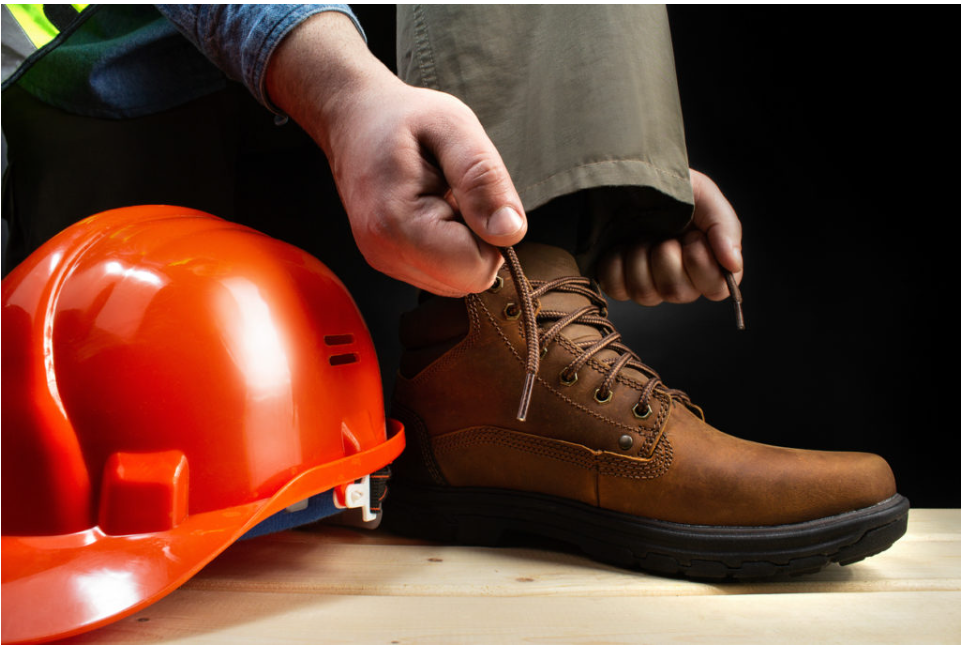
Safety boots, such as those with composite toe caps and steel toe caps, provide an important level of protection for workers' feet. In the event that something falls onto their feet, or they are injured in some other way, the safety boot can help to prevent more serious injury. This is why it is important for workers to wear safety boots when they are working in potentially dangerous environments.
Key Work Health and Safety Statistics, Australia 2021 provides an overview of the latest national data on work-related fatalities and workers’ compensation claims.

In 2020, there were 190 worker fatalities in Australia. This was an increase from 160 fatalities in 2019, and the highest number of annual fatalities since 2007 (when there were 202).
Transport, postal, and warehousing workers continued to be the most at-risk occupation group in 2020, with 36 fatalities (19% of the national total). This was followed by construction (26 fatalities, 14%), agriculture, forestry, and fishing (25 fatalities, 13%), and manufacturing (17 fatalities, 9%).
Serious claims by mechanism of incident, 2019-20p*
In 2019-20, there were 243,700 serious workers’ compensation claims lodged in Australia, an increase of 3% from the previous year.
The most common mechanism of injury resulting in a serious claim was being hit by moving objects (28%), followed by slips, trips and falls on the same level (22%) and being hit by falling objects (9%).
Ref: https://www.safeworkaustralia.gov.au/resources-and-publications/statistical-reports/key-work-health-and-safety-statistics-australia-2021#:~:text=Serious%20claims%20statistics%2C%202019%2D20p*
When choosing safety boots, it is important to consider the type of work that will be done in them. For example, if workers will be working in wet or oily conditions, it is important to choose boots with slip-resistant soles. It is also important to make sure that the boots fit well and are comfortable to wear, as this will help to prevent injuries.
What is a toe cap?
"Toe caps are fundamental components of safety footwear used to prevent injuries, which can be caused by falling objects. They can be realized by exploiting different materials (metal, composites, and polymers) and manufacturing processes (stamping, injection molding, compression molding, etc.)" - According to Comparative life cycle assessment of safety shoes toe caps manufacturing processes"
ref: https://link.springer.com/article/10.1007/s00170-022-09240-x
What are Composite Toe Safety Boots?
Composite toe safety boots are boots that have a protective cap made from composite materials. Composite materials are typically a combination of plastic and metal, which makes them strong and durable. This type of toe cap is ideal for workers who need to protect their feet from injuries caused by heavy or sharp objects.
Composite toe caps and plates are a type of safety footwear that offer protection for the toes. Unlike metal toe caps and plates, composite materials are used in the construction of these items. This makes them lighter and often more comfortable to wear than traditional safety boots. They are ideal for workers who need additional protection for their toes.
Composite Toe Boot Materials
Generally, composite toe work boots are made from two types of materials: thermoplastic and metal.
Workplace environments and risk factors vary enormously, and OH&S risk assessments should be conducted before choosing footwear protection. When choosing a composite toe boot, it is important to consider the needs of the individual worker. If strength and durability are more important than weight, then a steel-toe boot should be chosen. If weight is more important than strength, then an aluminum or plastic toe boot should be chosen.
Steel is the most durable material but it is also the heaviest. Aluminum is a lightweight option but it is not as strong as steel. Plastic is the least durable option but it is also the lightest. Rubber is a good middle ground between durability and weight. Composite toe caps are made from a wide variety of materials, differing from one supplier to the next. However, the most commonly used materials are:
- Fibreglass
- Carbon fibre
- Kevlar (aramid fibre)
- Graphite fibre
Thermoplastic toes are made from polycarbonate (PC) or polybutylene terephthalate (PBT) material, which is often used in vehicle bumpers because it is strong and durable. Metal toes are made from steel, aluminum, or titanium, and they are known for their high-impact strength.
What are Steel Toe Safety Boots?
Steel toe safety boots (also known as a safety boot, steel-capped boot, steel toecaps or safety shoe) are a type of footwear that is designed to protect the toes (that has a protective reinforcement) from injuries meeting Australian OHS standards (AS/NZS 2210.1). They are made from tough and durable materials that can withstand impacts and shocks. Steel toe caps can resist a drop force of 200 joules to offer premium protection for your toes.
Safety shoes are effective in keeping the feet of industrial workers safe from sharp and heavy objects while working in factories, construction workers, tradies, agriculture, automotive, and manufacturing.
Steel toe safety boots come in a variety of styles and colors, and are available for both men and women.
Ref: https://en.wikipedia.org/wiki/Steel-toe_boot
Composite Toe vs. Steel Toe Safety Boots. Which will protect you best?
Steel toe cap safety boots
Steel toe cap safety boots and shoes have a steel cap and provide protection against 200J of energy and bear a compression load of at least 15kN, meeting Australian OHS standards (AS/NZS 2210.1). They are the ‘classic’ option for protecting workers’ toes.
Pros of steel toe cap safety boots
- They are strong and offer protection against a range of different impacts and compressions.
- They are often cheaper than composite toe cap safety boots.
- They usually provide good levels of grip and traction.
- Higher protection levels make them ideal for use in environments with heavy hazards, such as machine handling.
- They do not shatter, and they do not snap, resulting in toe amputation!
- Steel caps are more economical to produce than composite toe caps, so they are often cheaper to buy
- They pass ASTM tests, meaning they are considered safe for workers handling electrical components
Cons of steel toe cap safety boots
- They can be heavy and uncomfortable to wear for long periods of time.
- They can conduct heat and cold, which can be unpleasant for workers in extreme temperatures.
Composite toe safety boots
Composite toe safety boots and shoes are a newer technology and are made from strong non-metal materials such as carbon fibre, Kevlar or plastic.
They meet Australian OHS standards (AS/NZS 2210.1) and are required to provide protection against 200J of energy. They also bear a compression load of at least 15kN. Composite toe safety footwear is usually lighter than steel toe safety footwear, and some brands make them waterproof.
Pros of Composite toe safety boots
- Composite toe safety boots are made of several materials that create a tough outer shell. This makes them much more durable than other types of boots and able to withstand more wear and tear.
- The composite toe is also non-conductive, meaning it will not conduct electricity if you come into contact with a live wire. This can be a lifesaver if you work in an environment where this is a risk.
- Composite toes are also immune to most chemicals, meaning they will not corrode or deteriorate like some other materials can.
- Lightweight design means they are comfortable to wear for long periods of time.
- Non-metallic materials means they do not set off metal detectors, making them a great choice for workers who need to pass through airport security.
- Provide better thermal insulation, meaning toes stay warmer in cold weather and cooler in hot weather.
So, which type of toe will protect you best? It depends on what your needs are. If you need something lightweight and waterproof, composite toe safety footwear may be the better option. If you need something heavy-duty and durable, steel toe safety footwear may be the better choice. Ultimately, it is up to you to decide which type of toe will work best for you and your needs.
Safety footwear standards: The safety performance requirements of work boots
Safety footwear is defined as:
Protective footwear that incorporates features to protect the wearer from injuries which could arise through accidents is fitted with toe caps. The toe caps are designed to give protection against impact when tested at an energy level of at least 200 Joules and against compression when tested at a compression load of at least 15kN.
The testing for standard AS 2210.3:2019 compliance covers many facets of the footwear construction including design, upper construction (including leather properties), linings, durability and slip resistance of outsole materials, insoles, toe protection and specific ergonomic features.
Certain workplace environments require additional protective features in footwear including penetration resistance, electrical properties, water resistance and metatarsal protection—these requirements are also addressed in additional clauses in the above standard.
It is imperative that the correct safety footwear is selected for the intended application.
Workplace environments and risk factors vary enormously, and OH&S risk assessments should be conducted before choosing footwear protection.
Ref: https://www.blundstone.com.au/work-boot-safety-standards
Electrical properties of footwear
Careful consideration should be given when selecting footwear to ensure it will provide the optimum protection in the environment where the footwear will be worn.
There are three categories of electrical conductivity in safety footwear.
When selecting footwear, it is important to consider the environment where it will be worn in order to ensure that it provides the optimum protection. There are three categories of electrical conductivity in safety footwear: dissipative, insulative, and conductive.
Electrical Hazard Resistant Footwear (EHR)
EHR footwear is designed to protect the wearer from electrical hazards, preventing them from being shocked if they come into contact with a live circuit.
The shoes are made of a variety of materials, including leather, rubber, and synthetic materials.
The non-conductive materials in EHR boots act as an insulator, preventing the flow of electricity out of the body through the feet. EHR footwear is available in a variety of styles, including slip-on, lace-up, and boot-style. EHR footwear is typically white or black in color.
When there is excessive wear on the outsole or when the non-conductive material is compromised, the level of electrical hazard protection of your footwear is severely lessened. It is important to make sure that you have an exit point for electrical flow so that you can be grounded and reduce the risk of electrocution.
Steel toe caps are insulated and should be replaced if safety toe caps become exposed.
EHR footwear is typically used by electricians, linemen, and other workers who are exposed to electrical hazards. The shoes are also commonly worn by students in electrical engineering programs.
EHR footwear must be tested to meet ASTM standard F2412-11 for impact and compression safety toe protection and ANSI standard Z41PT99 for electrical hazard resistance.
Anti-Static Footwear
Anti-static footwear should be used to minimise electrostatic accumulation emanating from the wearer. This can help reduce the risk of spark ignition from flammable substances and vapours, and electric shock.
Anti-static footwear can provide a reduced level of protection against electrical hazards compared to Electrical Hazard footwear.
The electrical resistance of anti-static footwear can be changed significantly by flexing, contamination or moisture. Repeated flexing can cause the material to break down and lose its anti-static properties. Contamination such as dirt, dust, and even oil can also reduce the effectiveness of the footwear.
Moisture from sweat or rain can make the material less effective at dissipating static electricity.
The product must be able to dissipate electrostatic charges while providing a high level of protection.
The user should establish an in-house electrical resistance test and carry it out at regular, frequent intervals.
Conductive Footwear
Conductive footwear helps to eliminate discharge in environments where the accumulation of static electricity on the wearer can be a hazard, such as while handling explosives or other volatile materials. While it does not provide any protection against electrocution, it is an important safety measure in these situations.
The following are important considerations when selecting conductive footwear:
- Type of material: The most common type of conductive footwear is made from leather or man-made materials. Some manufacturers also offer footwear made from natural fibers such as cotton.
- Sole: The sole of the conductive footwear should be made from a material that is electrically conductive. This will help to dissipate any static charge that may build up on the body.
- Fit: It is important that the conductive footwear fits well in order to avoid any gaps between the foot and the shoe. This could create a path for static discharge.
- Price: Conductive footwear can be expensive, so it is important to compare prices.
Ref: https://bld-website-storage.s3.amazonaws.com/BLU%20W_S%20E-Catalogue%20V2.2_pdf.pdf
Choosing The Right Work Boots For You
According to "The Effect of Work Boots on Knee Mechanics and the Center of Pressure at the Knee During Static Kneeling" cited in in Journal of Applied Biomechanics
Ref: https://journals.humankinetics.com/view/journals/jab/31/5/article-p363.xml
"Occupational kneeling is associated with an increased risk for the development of knee osteoarthritis. Previous work studying occupational kneeling has neglected to account for the fact that in many industrial settings, workers are required to wear steeltoe work boots."
"Therefore, wearing work boots alters the kneeling posture compared with barefoot kneeling, potentially loading different surfaces of the knee, as well as altering knee joint moments."
When choosing safety boots, it is important to consider the Standard that they comply to. AS 2210.3:2019 is the Standard for safety footwear in Australia, and all safety boots sold must comply to this Standard. However, not all safety boots are the same, so it is important to pick the correct pair for your customer.
Some factors to consider for choosing the right safety work boots include:
What type of work the customer does, their foot shape, and any specific needs or requirements they may have.
1. Fit for Purpose: When choosing footwear, be sure to consider the conditions you will be using them in. Make sure your shoes are appropriate for the activity you will be doing and that they provide the necessary support and protection.
2. Safety Toe Cap: Both steel and composite toes provide safety for multiple industries. It is important to select the right safety toe for the work conditions, as each type provides different levels of safety.
3. Safety footwear to be breathable, protective and supportive:
Workers need to be safe when on the job, and that means having the proper safety gear. Safety footwear is an important part of this gear, and it needs to be breathable, protective, and supportive. This type of footwear can help protect workers from injuries caused by falling objects or workplace accidents. It can also help keep their feet comfortable and safe during long shifts.
4. Sole Design + Material When it comes to slip resistance, it's important to consider the tread design and material. The material needs to be heat resistant as well.
5. Design for ankle or calf protection?
We recommend increased ankle and calf protection for those who need it, as well as a lightweight option for those who want it.
Ref: https://bld-website-storage.s3.amazonaws.com/BLU%20W_S%20E-Catalogue%20V2.2_pdf.pdf
Best Composite Toe Boots
What type of work the customer does, their foot shape, and any specific needs or requirements they may have.
1. Magnum Precision Max Side Zip Waterproof I-Shield Work Boot
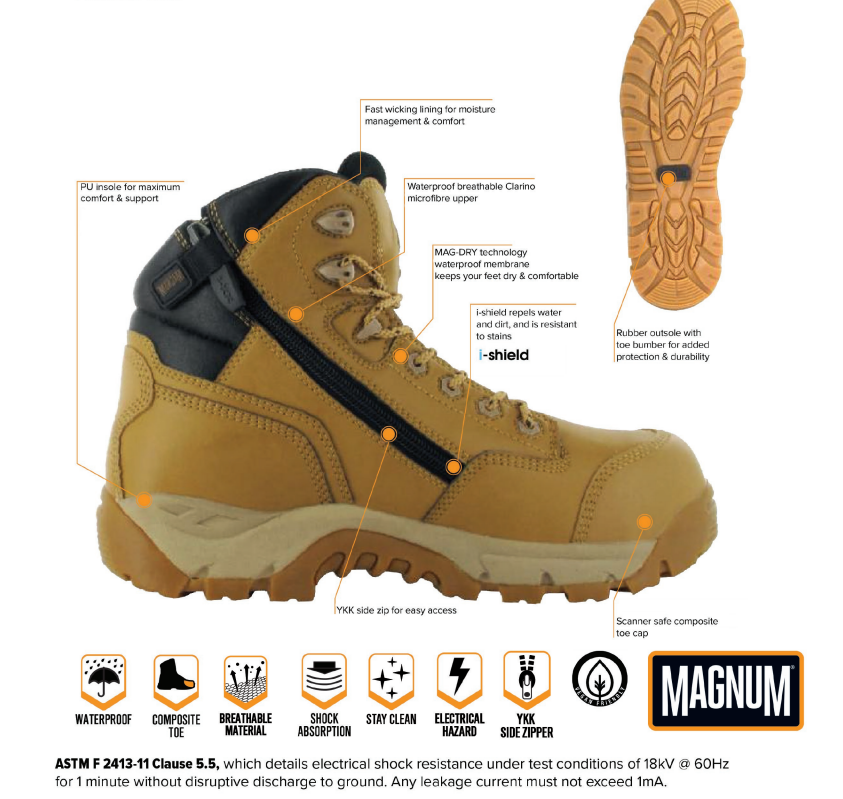
Magnum Precision Max Side Zip Composite Toe Waterproof I-Shield Work Boot available in Wheat. Certified to AS/NZS 2210.3:2019 SB AN WR E HRO SRA and Certified to ASTM F 2413-11 Clause 5.5. Has MAG-Dry technology for your comfort and to keep your feet dry.
Has the following features:
- PU insole for maximum comfort & support
- Fast wicking lining for moisture management & comfort
- Waterproof breathable Clarino microfibre upper
- MAG-Dry technology waterproof membrane keeps your feet dry & comfortable
- I-Shield repels water & dirt, and is resistant to stains
- Scanner safe composite toe cap
- YKK side zip for easy access
- Rubber outsole with toe bumper for added protection & durability
2. Magnum Roadmaster CT SZ CPSafety Work Boot Black
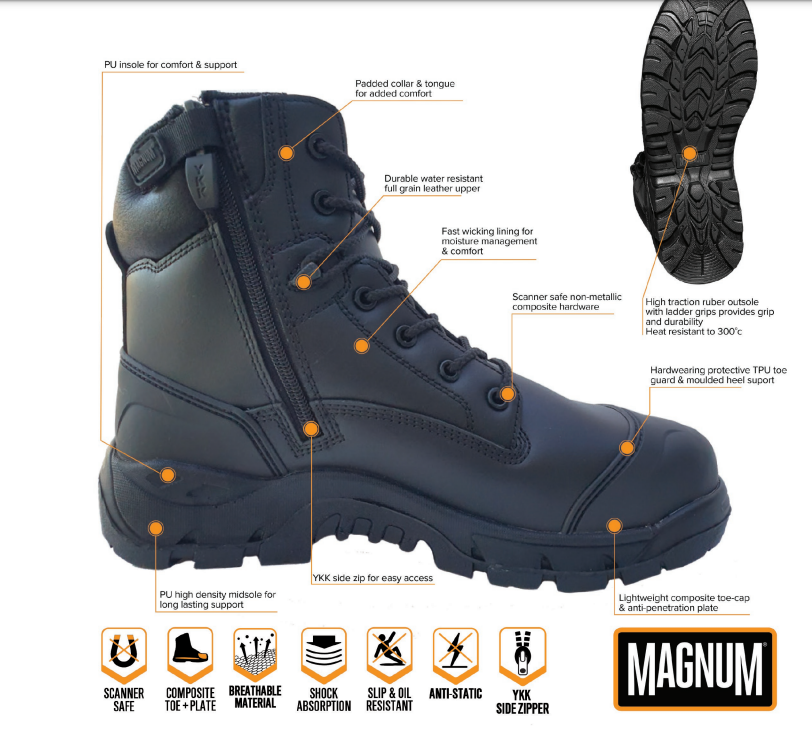
Magnum Roadmaster Composite Toe Composite Plate Side Zip Safety Boot in Black. Certified to Certified to AS/NZS 2210.3:2019 S3 HRO WR SRC A.
Features include:
- PU insole for maximum comfort & support
- Padded collar & tongue for added comfort
- Durable water resistant full grain leather upper
- Fast wicking lining for moisture management & comfort
- Scanner safe non-metallic composite hardware
- Hardwearing protective TPU toe guard & moulded heel support
- Lightweight composite toe-cap & anti-penetration plate
- YKK side zip for easy access
- PU high density midsole for long lasting support
- High traction rubber outsole with ladder grips provides grip and durability. Heat resistant to 300°c
2. Bata Longreach Composite Toecap Side Zip
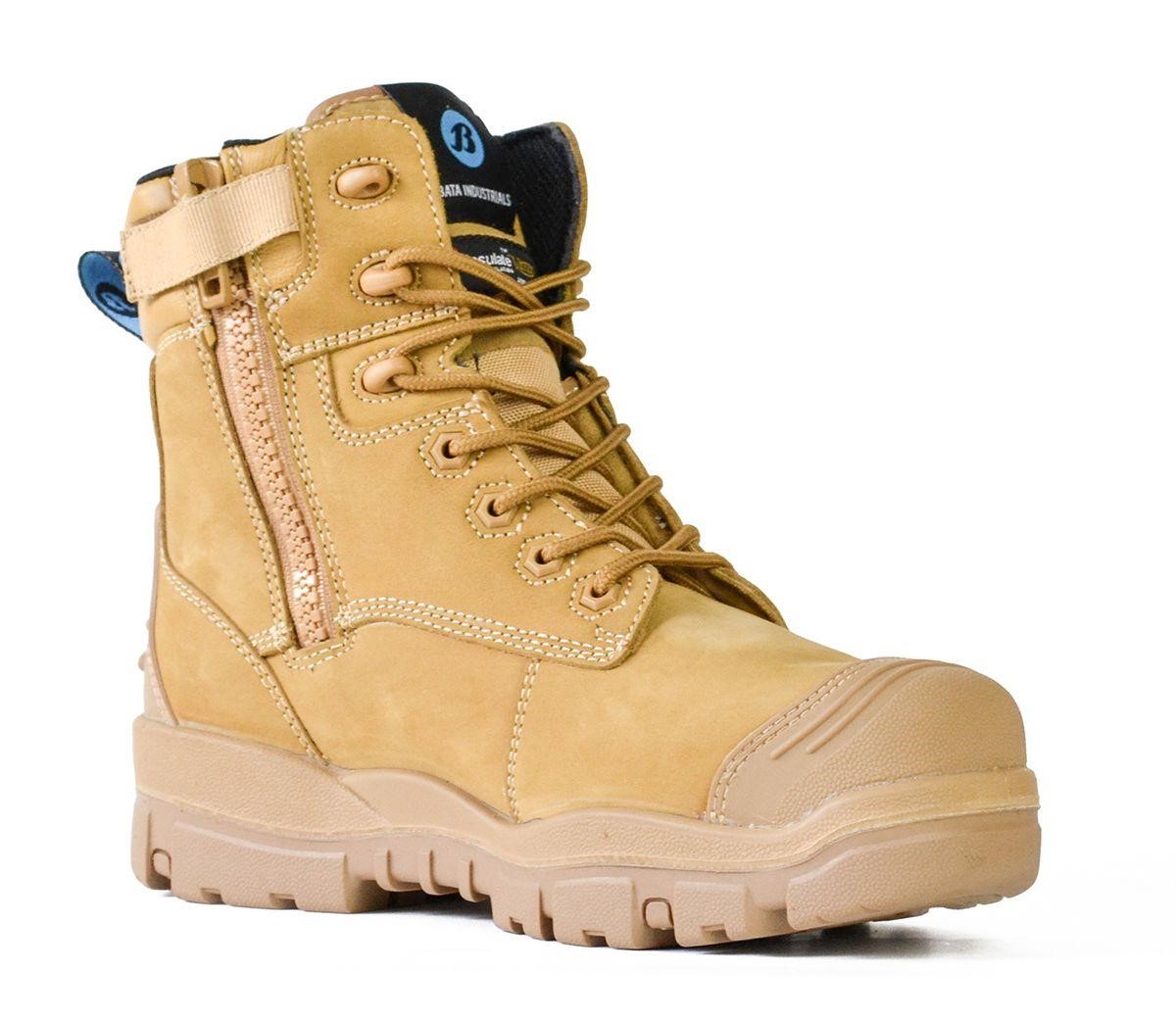
Bata Longreach Composite Toecap Side Zip -Premium 6" metal free zip sided lace-up ankle boot. Certified to AS 2210.3:2019 SRC and Certified to ASTM F2413-18 EH Resistant.
Suitable Industries: Mining, Construction, Landscaping
According to University of Wollongong online research - Dissatisfaction with work boot design is common in the mining industry. Many underground coal miners believe their work boots contribute to the high incidence of lower limb injuries they experience.
"358 underground coal miners (355 men; mean age = 39.1 ± 10.7 years) completed a 54-question survey regarding their job details, work footwear habits, foot problems, lower limb and lower back pain history, and work footwear fit and comfort. "
"Results revealed that underground coal miners were not satisfied with their current mining work boots. This was evident in the high incidence of reported foot problems (55.3%), lower back pain (44.5%), knee pain (21.5%), ankle pain (24.9%) and foot pain (42.3%). "
"Over half of the underground coal miners surveyed believed their work boots contributed to their lower limb pain and reported their work boots were uncomfortable. Different working roles and environments resulted in differences in the incidence of foot problems, lower limb pain and comfort scores, confirming that one boot design cannot meet all the work related requirements of underground coal mining."
Ref: https://ro.uow.edu.au/cgi/viewcontent.cgi?article=5989&context=smhpapers
With Bata Longreach Composite Toecap Side Zip designed for mining and construction workers is featured with Padded Collar & Tongue - Added foam around the ankle & shin area to provide better support, stability and comfort.
Composite Toecap - Non metal toe cap offers protection against injuries and can withstand a force of up to 200 joules.
D30® Impact Protection - Comfort & impact absorption to help soften the weight of working on your feet all day.
Other Features Includes:
- Nomex Stitching - Sewing thread that is made from heat and fire retardant meta-aramid fiber.
- Armour Layer Midsole Protection - Advanced non-metal midsole that protects the foot against sharp objects penetrating through the sole.
- Toe Scuff Protection - Added toe scuff and abrasion protection to prolong the life of the boot.
- EH Protection - Minimises the flow of electricity to the ground, reducing the risk of electrocution.
- Slip & Oil Resistant - Designed to meet the slip & oil resistance for standard AS/NZS 2210.3.
- Heat Resistant Rubber Outsole - Durable outsole can withstand extremely high temperatures of up to 300°C.
- 3M™ Scotchgard™ Protection - Added leather protection from oil and water and also makes cleaning easier.
- Life Natural Anti-Odour Lining - Plant-based antimicrobial protection that eliminates 99% of odour causing bacteria.
- 3m™ Thinsulate™ Insulation - Fine mircofibers help trap air and block body radiation heat loss, making it an efficient insulator.
4. Magnum Strike Force 6.0 SZ CT Booth

Magnum Strike Force 6.0 Side Zip Composite Toe Boot is Certified to AS/NZS 2210.3:2019 SB E FO CI HI HRO AN SRC and Certified to ASTM F 2413-11 Clause 5.5
Suitable industry: Law Enforcement, Security, Military, Fire & Rescue, Healthcare, Service, Construction and Industrial professionals.
This safety boot uses EXOGEL for ultimate ankle impact protection and M.P.A.C.T. PRO moulded PU insole delivers superior long-term cushioning and high rebound along with high-level breathability and moisture management.
5. Magnum Precision Max SZ CT Wpi Work Boot
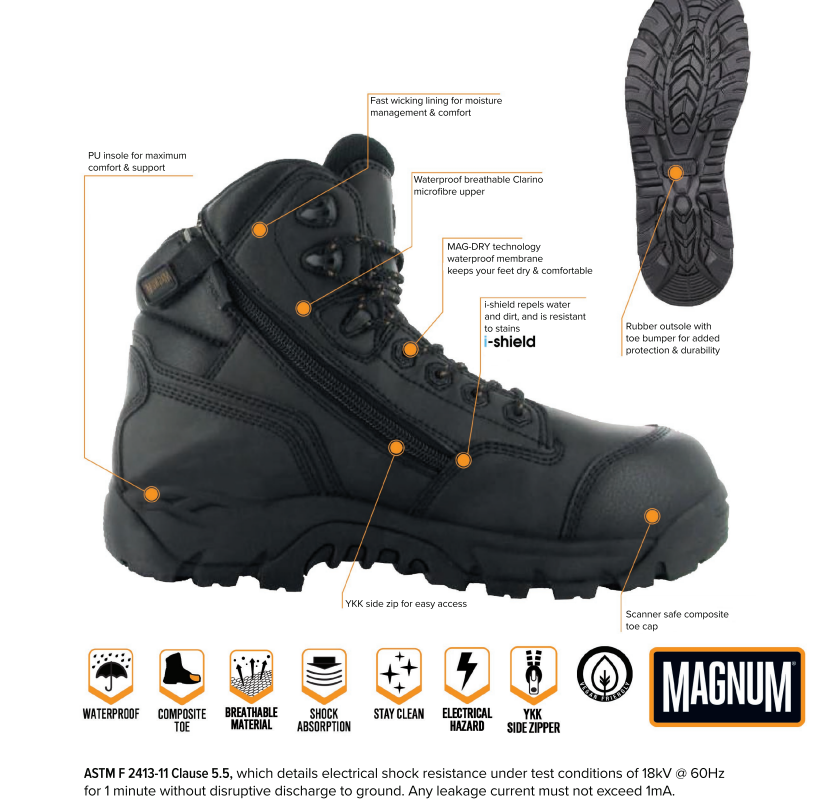
Magnum Boots - Precision Max Size Zip Composite Toe Waterproof I-Shield Work Boot is Certified to AS/NZS 2210.3:2019 SB E FO CI HI HRO AN SRC and Certified to ASTM F 2413-11 Clause 5.5
Suitable industry: Law Enforcement, Security, Military, Fire & Rescue, Healthcare, Service, Construction and Industrial professionals.
Best Steel Toe Boots with Composite Plate
Bison XT Ankle Lace Up Safety Boot With Zip
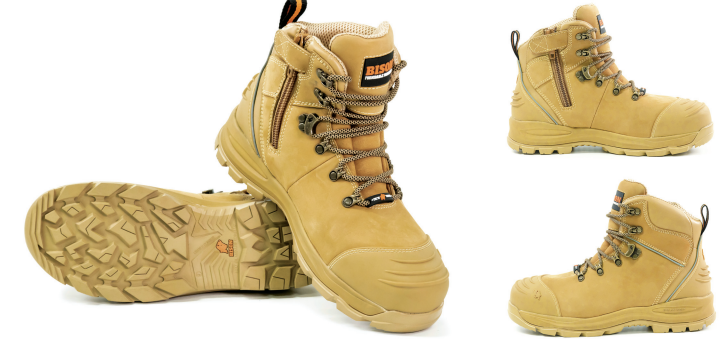
Bison XT Ankle Lace Up Safety Boot with Composite Plate Footwear and Steel toe cap. Certified to AS 2210.3:2019 Lic. BMP 708413 and EN ISO 20345:2011 Lic. BMP 708414. Class 1 SBP, SRC, FO. (EH) ASTM F241317 Sect 5.5.
Suitable Industries - Construction & Trades, Infrastructure & Civil, Agriculture & Forestry, Oil & Gas, Mining, Manufacturing.
Best Steel Toe Boots
1. Bata Dakota Ladies Safety Boots
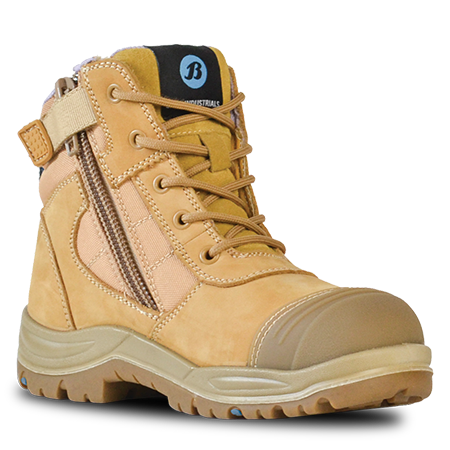
Bata Dakota Ladies Safety Boots with Steel toecap -200J. specifically to fit the ladies foot with maximum comfort, support and durability in mind. Featuring a rubber outsole that is heat resistant to 300°C and D3O® impact protection for increased shock absorbing heel cushioning, the Dakota is built for comfort and made to work.
Suitable industry: Construction, Food & Beverages, General trades, Security, Transport & Logistics.
2. Bata Utility Gumboots
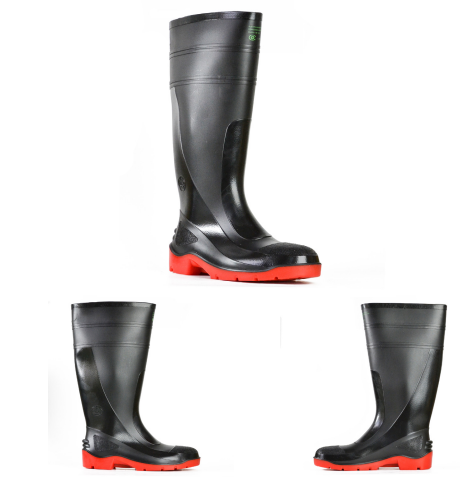
Bata Utility Gumboots 400mmH PVC safety toe gumboot - Steel Toe Cap - Capable of resisting a drop force of 200 joules to offer premium protection for your toes. Certified to AS 2210.3:2019 SRA and Certified to ASTM F2413-18 EH Resistant.
Industry - Landscaping, Gardening
3. Bata Hercules Elastic Sided Ankle Boot
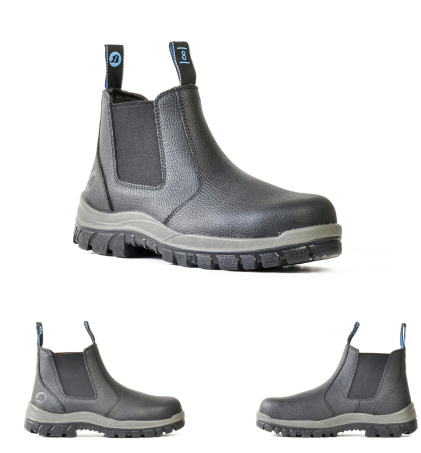
Bata Hercules Elastic Sided Ankle Boot with Steel Toe Cap - Capable of resisting a drop force of 200 joules to offer premium protection for your toes. Certified to AS 2210.3:2019 SRA.
Industry - Agriculture, Automotive, Manufacturing
4. Bison Dune Low Cut Zip Side Lace Up Safety Boot
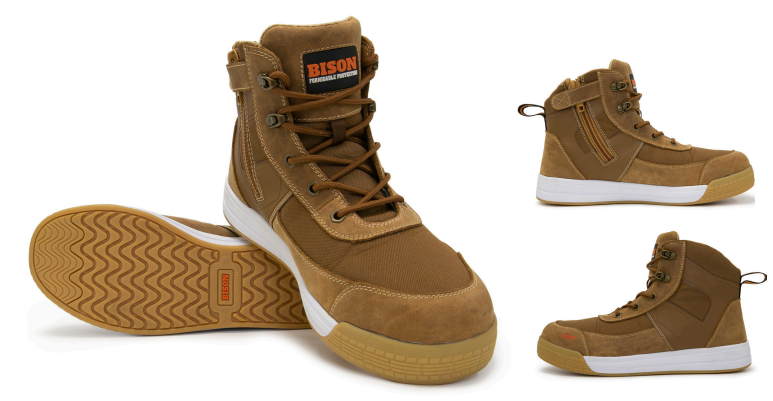
Bison Dune Low Cut Zip Side Lace Up Safety Boot with Steel Toe Cap - Capable of resisting a drop force of 200 joules to offer premium protection for your toes. Certified to AS 2210.3:2019 Lic. BMP 708413 and EN ISO 20345:2011 Class 1 Lic. BMP 708414. SB SRC FO.




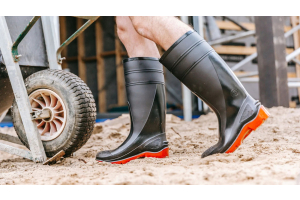
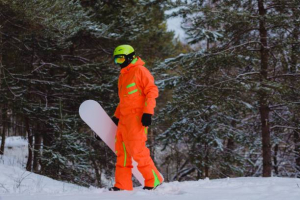
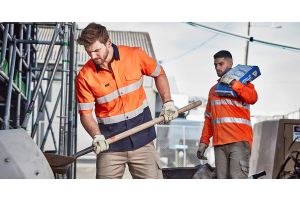
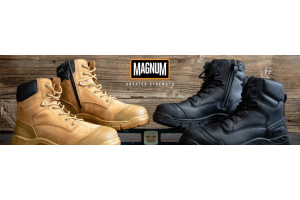

Please complete your information below to login.
Sign In
Create New Account